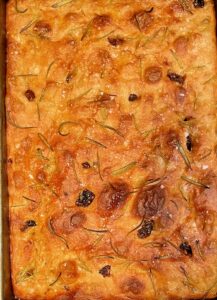
Focaccia with rosemary and sun-dried tomatoes
This is a recipe from Kitchen & Craft, with some very slight modifications. Check out the excellent video posted on YouTube called Amazing Focaccia Bread | How to make it in 6 easy steps.
Even though there are a lot of steps in this process, each step is easy, and the results are fantastic.
Cooking Time
- 35 minutes, + start at least 12 hours in advance – for example, start the dough the evening before you plan to cook the focaccia.
Ingredients for one 9” by 13” loaf of focaccia
- Total flour: 600 grams, or 4 and ½ cups:
You can use all-purpose flour, or a combination of all-purpose and wheat flour. In the pictured version shown here, I used 400 grams of organic all-purpose flour and 200 grams of wheat flour. - Warm Water, 75 – 450g (2 cups)
- Coarse Sea Salt – 6g (3/4 tsp.)
- Extra Virgin Olive Oil – 20g (2 tbsp.)
- Active Dry Yeast – 1/4 tsp
- Handful chopped sundried tomatoes (optional)
Toppings
- Fresh shredded rosemary
- Handful freshly grated Parmigiano Reggiano cheese (optional)
- Coarse salt
Preparation
- Watch the video for a quick tour of the whole process.
- In a large bowl, combine the flour and active dry yeast. Use a whisk to mix the yeast and flour.
- If you are adding chopped sun-dried tomatoes or chopped olives, add them now and give the flour, yeast a quick mix to distribute them through the dry ingredient bowl.
- In a separate, medium-sized bowl, combine the tepid/warm water with the salt. Stir to combine.
- Pour the water and salt into the large bowl containing the flour, active dry yeast, and the optional sundried tomatoes or olives. With a wooden spoon, mix the combined ingredients together in the bowl for a minute or two until you have a doughy ball that is slightly damp.
- Add the 2 tablespoons of extra-virgin olive oil, then use your hands to knead the dough for a couple of minutes. You can pinch the dough with your fingers as you gently knead it together until it forms a soft, damp ball.
- Coat another large bowl with a bit of olive oil and transfer the dough to the oiled bowl. Cover it with plastic wrap and allow the ingredients to rest for a half an hour.
- Now, for a total of 4 times, every twenty to thirty minutes, “pull” or “fold” the dough in a rotating fashion until you have rotated/folded the dough 360°. Re-cover the bowl and allow it to rest until another 20-30 minutes have passed.
- After you’ve completed the rotation/folding process at least 4 times, re-cover the bowl with plastic wrap and put it in the refrigerator overnight. In the morning, or a couple of hours before you plan to bake it, take the bowl out of the refrigerator.
- Coat a 9” by 13” baking pan with a layer of extra-virgin olive oil. (I have have experimented with aluminum and ceramic baking pans and have concluded that the aluminum baking pans are best, because the foccacia never sticks to the bottom). Transfer the dough into it and gently stretch the dough evenly until it is spread through the whole pan.
- Cover the baking pan with plastic wrap and put it into an un-heated oven with its light on. The temperature needs to be around 80- 90°F, which is generally the temperature of an oven with its light turned on. If you aren’t confident of the temperature, you can boil a small pot of water and put the steaming pot into the bottom of the oven beneath the bread. Leave the dough to proof for about an hour. This is the second proof.
- Remove from the oven, take of the plastic wrap, and with wet fingers, gently press into the dough to dimple it. Re-cover with plastic wrap and pop it into the unheated oven for another 45 minutes.
- Take it out of the oven. Bring the oven to 450° F. While the oven is pre-heating, you can finish the focaccia dough by sprinkling the top with fresh rosemary leaves. Add some sea salt on top and then sprinkle some olive oil over the entire surface (I use a plastic squeeze bottle to spread the olive oil evenly).
- Put the dough into the pre-heated oven. Bake for 15 to 20 minutes.
- Remove from the oven and put the hot pan onto the top of the stove or a rack. Allow to cool for 10 minutes and then gently remove it from the baking pan and let it sit on the rack. (If you wait too long, it will stick, and it’s a devil to get it out of the baking pan!)
- Add a little more olive oil to the top surface. Now — avoid temptation and let the focaccia rest on the rack for another 15 minutes.
Enjoy the results!

